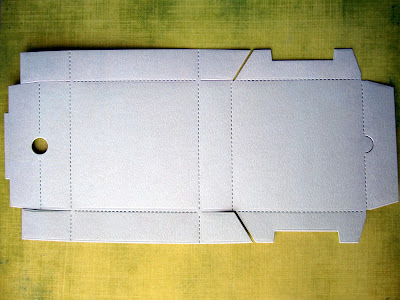In today's post, I wanted to go old school and whip out my traceable templates. I wanted to compare them to metal dies and see if the time spent manually tracing and cutting is worth it.
So I'll start with the finished product and then show you the differences I found between these two ways of making a classic pizza box shape.
So here are the two different methods I used to create two different pizza boxes: a traceable template from Oriental Trading Company for the first box and a metal die from Lifestyle Crafts for the second box.
Here are what the shapes looked like after I traced them and cut them out or ran them through a die cut machine. The top picture is the traceable template and the bottom picture is the die cut shape.
Now here is where a major difference comes into play--the folding! With the template I traced and cut, I had to use a folding tool to make the folds correct. With the metal die, the fold lines are perforated, so the paper folds easily where it should.
Here's how the finished boxes look. The traced template box is the smaller one on the left and the die cut box is the bigger one on the right.
Here's a comparison view of them when open. The traced template box is the one in front.
So what are the conclusions? Here are the pro's and con's summarized in addition to the differences you can see from looking at the pictures.
Pro's of Traceable Templates when Compared to Metal Dies
Price, price, price!! I bought a 10-pack of plastic templates for under ten bucks. That adds up to less than a dollar per template. That is significantly cheaper than buying a metal die. Metal dies can cost $39.99+ for one single shape. And if you use a metal die, you need a die cut machine, and the machines often stretch into the triple digits.
Nice tight fit with clean folds. As you can see from the pictures, the traced template pizza box seems to have cleaner lines and tighter folds. Overall, the completed box felt sturdier and looked better in some ways. While the dotted lines on the die cut shape allow for easy folding, some people do not love how they look on the finished product. You don't have these perforated folds when you use the template.
Con's of Traceable Templates when Compared to Metal Dies
Durability. I guess you get what you pay for. While traceable templates are a major bargain, after enough time has passed, the plastic will get brittle. Obviously they won't hold up as well as a metal die.
Time. Tracing and cutting out a shape takes significantly longer than running the shape through a die cut machine. In addition to just tracing and cutting the straight lines, you also have to cut the intricate shapes with scissors (like that crescent-shaped closure on the lid) and that's just plain tricky. Also, it takes longer to fold because the lines aren't perforated (which aesthetically looks better in some people's opinions, but does require more effort on your part).
So
there you have it: pro's and con's to both. I tend to focus on shapes
rather than methodology. If I see a shape I like, I buy it whether it's
a traceable template, a manual die, or an electronic die cut shape. Go
with what you're drawn to and if it doesn't fit in your budget, just
know that there are always alternatives. So don't rule out those
traceable templates! There are some cool traceable template boxes that I have yet to see in a metal die format. I think it's great that the world of die cutting
has become vast enough to give us similar products in varying price
points.






